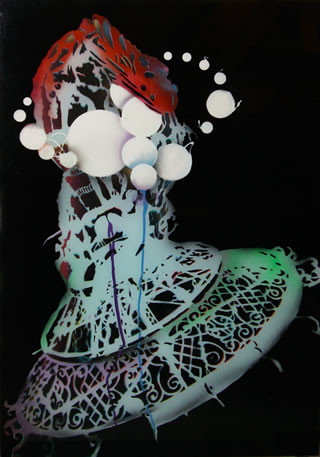Simon Periton
dal 24/2/2009 al 27/3/2009
Segnalato da
24/2/2009
Simon Periton
Sadie Coles HQ (old location), London
The way in which the work is made is almost alchemical. Periton's interests in social freedoms, alternative social models (successful or failed), decoration, and pattern prevail, but his abdication of effect to the chance processes of production allows the work to slide neatly into the esoteric hinterlands that captivate him.

A number of pieces are silvered on the back, and it is here that the clue to the show’s name lies. Spirits of Salt, though it may sound supernatural, is in fact the household name for a hydrochloric acid solution – the only thing that will remove the silver from an old mirror. It is in this kind of perverse detail – the poetry of the ordinary - that Periton delights.
The way in which the work is made is almost alchemical. Periton’s interests in social freedoms, alternative social models (successful or failed), decoration, and pattern prevail, but his abdication of effect to the chance processes of production allows the work to slide neatly into the esoteric hinterlands that captivate him. It teeters ever on the brink of the otherworldly, at points broaching the studiedly peculiar realms of science fiction. For Periton, the illusory aspects of the work underscore how much of a fiction painting can be. Indeed, a tension arises out of the simultaneous success and failure of artistic and utopian ideals. As with Periton’s earliest anarchy doilies, the original intention is not to make art that is political, but rather to question those very stances that purport to be an effective means of change.
Simon Periton was born in England in 1964 and studied at Central St Martin’s School of Art, London. He has exhibited widely in Britain and internationally. Solo shows include Mint Poisoner, Inverleith House, Royal Botanic Garden, Edinburgh, 2003. Periton’s work is to be included in a prominent group show at Tate St Ives later this year. Other group exhibitions have included Wunschwelten, Schirn Kunsthalle, Frankfurt, Germany, 2007, and the 2007 and 2004 Summer Exhibitions at the Royal Academy, London. Commissions include public sculpture projects for firstsite, Colchester, Essex, Channel Four, and the Victoria and Albert Museum. A monograph of his work with an essay by Michael Bracewell was published in 2008 by Koenig Books Ltd and Sadie Coles HQ. Simon Periton lives and works in London.
Sadie Coles HQ
35 Heddon Street - London
Free admission



